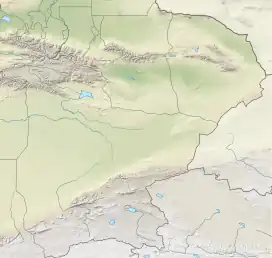Subashi Formation
The Subashi Formation (Chinese: 苏巴什组) is a Late Cretaceous (Campanian to Maastrichtian)[1] formation from the Xinjiang Autonomous Region of western China.[2] Initially described by Dong Zhiming in 1977, the formation contains remains of Tarbosaurus which were initially described as a separate taxon Shanshanosaurus huoyanshanensis. Remains of a sauropod, likely Nemegtosaurus, and a hadrosaurid, likely Jaxartosaurus, have also been found.
| Subashi Formation | |
|---|---|
| Stratigraphic range: Campanian-Maastrichtian ~ | |
| Type | Geological formation |
| Overlies | Unconformity with Kumtax Formation |
| Lithology | |
| Primary | Red or variegated sandstone |
| Other | Mudstone |
| Location | |
| Coordinates | 43.1°N 91.8°E |
| Approximate paleocoordinates | 39.6°N 82.8°E |
| Region | Xinjiang |
| Country | |
| Extent | Turpan Basin |
| Type section | |
| Named by | Dong Zhiming |
| Year defined | 1977 |
 Subashi Formation (Bayingolin) | |
The formation is located in the Flaming Mountains region of Xinjiang, north of the Turpan Depression. It is not far from Lianmuqin Town of Shanshan County,[3] and is presumably named after the village of Subashi (42°55′11″N 89°44′36″E), which is located some 15 kilometres (9.3 mi) to the west of Lianmuqin, in Tuyugou Township (吐峪沟乡).
Fossil content
The following fossils were reported from the formation:[2]
- Reptiles
- Euoplocephalus sp.[4]
- Gravemys hutchisoni[5]
- Jaxartosaurus
- Nemegtosaurus pachi[6] - "Teeth."[7] - (sauropod indet.)
- Tarbosaurus bataar[6]
- Tyrannosaurus turpanensis[6] - "Teeth and sacral vertebrae."[8] - (tyrannosauroid indet.)
- Coelurosauria indet.[9]
- Titanosauridae indet.[10]
- Fossil eggs
- Elongatoolithus andrewsi[11]
- Elongatoolithus elongatus[4]
- Ovaloolithus turpanensis[12]
See also
References
- Xi et al., 2018
- Subashi Formation at Fossilworks.org
- Glut, 2001
- Zhai et al., 1978
- Yeh, 1974
- Dong, 1977
- "Table 13.1," in Weishampel et al., 2004, p.271
- "Table 5.1," in Weishampel et al., 2004, p.114
- Shen & Mateer, 1992
- Dong, 1997
- Dauphin, 1994
- Zhang & Wang, 2010
Bibliography
- Xi, D.; X. Wan; G. Li, and G. Li. 2018. Cretaceous integrative stratigraphy and timescale of China. Science China Earth Sciences 61. 1–31. . doi:10.1007/s11430-017-9262-y
- Zhang, S.-K., and Q. Wang. 2010. A new species of ovaloolithids from Turpan Basin in Xinjiang, China. Vertebrata PalAsiatica 48. 71-75. .
- Glut, Donald F. 2001. Dinosaurs, the encyclopedia: Supplement, Volume 1, 497. McFarland & Co... ISBN 078641166X
- Dong, Z. 1997. On a large claw of sauropod from the Upper Cretaceous in the Turpan Basin, Xinjiang, China. In Z. Dong (ed.), Sino-Japanese Silk Road Dinosaur Expedition China Ocean Press, Beijing, 111-112.
- Dauphin, Y. 1994. Comparaison des microstructures et de la composition chimique de coquilles d'oeufs fossiles du Sud de la France, de quelques specimens d'Asie et d'oiseaux actuels. Neues Jahrbuch für Geologie und Paläontologie, Abhandlungen 194. 55-71. .
- Shen, Y.-b., and N. J. Mateer. 1992. An outline of the Cretaceous System in northern Xinjiang, western China. In N. J. Mateer, P.-j. Chen (eds.), Aspects of Nonmarine Cretaceous Geology China Ocean Press, Beijing, 50-77.
- Zhai, R.-j.; J.-j. Zheng, and Y.-s. Tong. 1978. Stratigraphy of the mammal-bearing Tertiary of the Turfan Basin, Sinkiang. Reports of Paleontological Expedition to Sinkiang. III. Permian and Triassic Vertebrate Fossils of Dzungaria Basin and Tertiary Stratigraphy and Mammalian Fossils of Turfan Basin 13. 68-81. .
- Dong, Z. 1977. On the dinosaurian remains from Turpan, Xinjiang. Vertebrata PalAsiatica 15. 59-66. .
- Yeh, H. 1974. A new fossil dermatemydid from Sinkiang. Vertebrata PalAsiatica 12. 257-261. .
- Young, C.-C. 1965. Fossil eggs from Nanshiung, Kwangtung and Kanchou, Kiangsi. Vertebrata PalAsiatica 9. 141-170. .